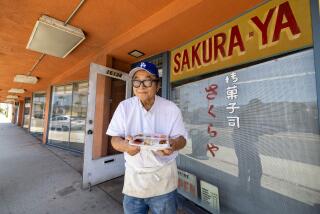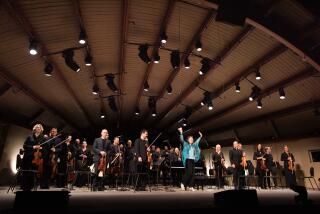Tour Retraces Ojai’s History
- Share via
If you thought the name Ojai was a Chumash word for nest, you’ve got a lot of company--but you’re mistaken.
It means moon, or cycle of the moon. And Topatopa, the name of those mountains that nestle the Ojai Valley? You’re wrong again if you swore it meant gopher-gopher. It means much cane--so named for the reeds with which the Native Americans used to make their homes and baskets.
Betty McAllister sorts out the long-standing name confusion during walking tours she leads through downtown Ojai on the first and third Saturdays of the month.
She delves into Ojai’s history on the 90-minute stroll, which takes participants past places of historical interest, such as the post office with its distinctive tower and the old homes of the town’s pioneers.
As for the name Ojai, she puts forth one theory on why the nest interpretation has doggedly prevailed.
“I guess when people moved here, they felt like they were in a nest,” McAllister said. “It’s really hard to get out of people’s heads.” Even docents sometimes make the mistake.
That’s not all you’ll glean about Ojai’s name on the tour. For starters, it wasn’t the city’s original name. That was Nordhoff, for Charles Nordhoff, the journalist who wrote glowingly of the area and attracted Easterners.
The old name is common knowledge in Ojai, but not so well known is why it became Ojai when the city incorporated in 1921: Anti-German sentiment was high after World War I, and Nordhoff’s German-sounding name offended some in the town.
McAllister is offering the tours as part of a community service project through Ojai’s Living Treasures, an organization that screens and selects worthwhile community projects. McAllister, a member of the city’s Historic Preservation Commission, will provide the tours through May, and starting again in November through May 1998.
She’s not only hooked on history, she has lived in Ojai for 38 years. The tours are heavy on history and include a smattering of information on the town’s architecture and its pioneers.
*
Ojai probably wouldn’t look much like it does today had it not been for two devastating fires in 1917 and the foresight of Edward D. Libbey, a wealthy Ohio glass industrialist who came to vacation and became enamored with the town.
Early that year a forest fire in Matilija Canyon swept into Ojai, burning 60 homes and two churches. The following November, most of the stores along the arcade burned when a pot of syrup boiled over in the downtown candy shop, igniting a blaze.
“He redeveloped the town,” McAllister said. Using much of his own money, Libbey’s urban renewal efforts gave the rural western town a new look: mission revival.
He was behind the building of the arcade in 1917 that runs along the downtown business district. He had a hand in Ojai’s statuesque post office and other buildings, like the old St. Thomas Aquinas Chapel on Ojai Avenue, the only building in Ojai on the National Registry of Historic Places.
The tour involves about a mile of walking and about 20 stops, with McAllister dishing out historical tidbits along the way.
In oak-canopied Libbey Park, walkers will see an odd sight: Ojai’s early jail. “Most people think it’s a restroom,” she said.
Built in 1928, it’s a small, window-less building with 8-inch-thick concrete block walls. In the old days, no guard was posted there at night, but officers at the police station on Ojai Avenue had an inventive system for keeping tabs on prisoners.
Using wires, they strung an early-day intercom system of sorts from the station through the oak trees to the jail.
The old jail was used into the 1970s, when the new one was built. A move to tear down the old jail was resisted, and since then it has been repainted and given a new tile roof.
Also in Libbey Park, walkers will see Libbey Bowl, the natural amphitheater that has drawn some big names in music, such as Aaron Copeland and Igor Stravinsky.
Nearby, a huge, old sprawling sycamore tree is known as the “peace tree.” The Chumash believed the tree was sacred, and it served as a spot where they discussed their differences, thus avoiding conflict.
The tour passes Ojai’s original schoolhouse, built in 1874 of handmade bricks. (It’s now the Ojai Manor Hotel, a bed-and-breakfast inn.) The route swings by the first library (1883) and the first church, the Nazarene Church (1884).
*
It makes a stop at Bill Baker’s Bakery on Ojai Avenue. Bill Baker is long gone, but his legacy remains in pictures on the wall. Born in Germany, he changed his name from Koch to Baker and bought the bakery in 1923. According to McAllister, he had the reputation of a Picasso with an icing bag: His cakes were in demand by U.S. presidents.
McAllister weaves in tidbits about other Ojai people, like Tom Clark, who was a county supervisor from 1904 to 1936. He had a passion for chariot racing, a popular sport back then, which he practiced at the county fairgrounds. That’s how he won the nickname of Ben Hur.
*
DETAILS
* WHAT: Historical walking tours of downtown Ojai.
* WHEN: 10-11:30 a.m. Saturday; the first and third Saturdays of the month through May.
* WHERE: Meet at the Ojai Visitors Center, Ojai Avenue and Blanche Street.
* HOW MUCH: Free.
* FYI: 646-8126.
More to Read
Sign up for The Wild
We’ll help you find the best places to hike, bike and run, as well as the perfect silent spots for meditation and yoga.
You may occasionally receive promotional content from the Los Angeles Times.






